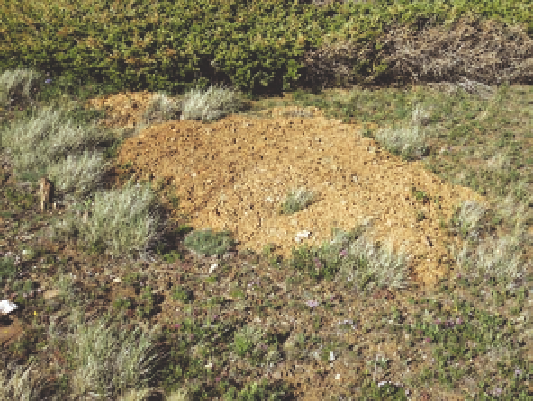Geoscience Reference
In-Depth Information
Wet
meadow
Willow
thicket
common name
Latin name
Fellfield
Alpine turf
ebony sedge
Carex ebenea
—
—
X
X
obtuse sedge
Carex obtusata
—
—
X
X
Water sedge
Carex aquatilis
—
—
X
X
SHRUBS
Alpine laurel
Kalmia microphylla
—
—
X
X
Alpine willow
Salix petrophila
X
—
—
—
cascade willow
Salix cascadensis
—
—
—
X
Diamondleaf willow
Salix planifolia
—
—
—
X
Grayleaf willow
Salix glauca
—
—
—
X
Snow willow
Salix reticulata
X
—
—
—
Resin birch
Betula glandulosa
—
—
X
X
a
A dash indicates that the plant is absent or uncommon.
slipping or creeping downward. Formed over long peri-
ods, solifluction lobes or terraces cause a distinctive pat-
tern (fig. 14.11).
cryoturbation and solifluction, combined with the
burrowing of pocket gophers (fig. 14.12), are thought
to be continual sources of disturbance to alpine vegeta-
tion, creating a mosaic of patches and raising questions
about whether a stable tundra ecosystem ever devel-
ops. However, gradual changes occur over time scales
of centuries. to illustrate, with gradual weathering and
soil development, boulder fields develop into fellfields,
which can become dry meadows, commonly known as
alpine turf. Similarly, wet meadows dominated by water
sedge develop into somewhat drier meadows dominated
by tufted hairgrass. on a smaller scale, episodes of cryo-
Disturbances that occur in alpine tundra are dis-
tinctly different from those occurring in ecosystems at
lower elevations. However, numerous plants and ani-
mals have evolved adaptations for this environment
and are not found elsewhere. Some observers refer to
tundra as fragile, because recovery after disturbances is
slow. to be sure, excess livestock grazing and damage
caused by foot traffic and off-road vehicles can cause
undesirable changes that persist for many decades.
35
Nitrogen Deposition
nitrogen fertilization experiments in alpine tundra
commonly lead to an increase in plant growth, indicat-
ing that nutrients can be limiting along with the cool,
such as alpine clover, but they are not widespread.
Fig. 14.10. Frost boils, such as this one on Libby Flats in the
Medicine Bow Mountains, create small patches in the tundra
vegetation. Burrowing mammals, like the Wyoming ground
squirrel, may be beneficiaries of the loose soil, or they may be
involved with forming such features. elevation 10,500 feet.












Search WWH ::

Custom Search